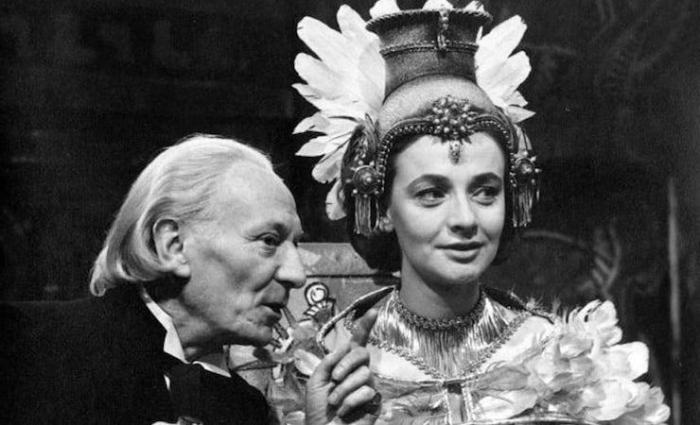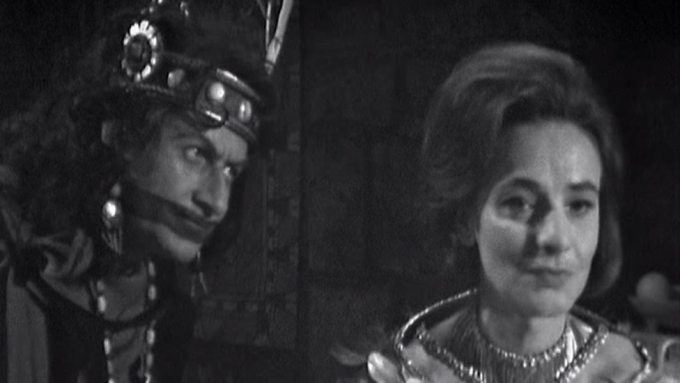
It’s apt that the episode opens with a scene between Barbara and Susan (we don’t see the Doctor and Ian until we’re a few minutes in). Barbara is very much the focus of the story, as might be guessed when we learn that she knows something about the Aztec civilisation.
As a history teacher, with a special interest in the Aztecs, she regards her surroundings with the eye of an expert. But if the story is designed to teach us anything, it seems to suggest that her book knowledge leaves her woefully unprepared to deal with the realities that she finds.
Susan operates as Barbara’s line-feeder here, helpfully informing the viewers that they’re in Mexico (sometime before 1430) as well as giving us the nugget of information that the Aztecs favoured human sacrifice. But Barbara is quick to point out that they had their cultured and civilised side as well and it’s this duality which will form the dramatic centre of the story.
It’s possible to see parallels between this and Lucarotti’s previous story, Marco Polo. Both feature two central guest characters – one who tends to side with the Doctor and his friends (Marco/Autloc) with the other standing in opposition to them (Tegana/Tlotoxl). What’s different about The Aztecs is how the four time-travellers are on shaky ground from their first appearance – Barbara is masquerading as the reincarnation of the goddess Yetaxa and so risks being unmasked at any moment. This gives the story a different feeling from Marco Polo, where Marco’s patronage ensured the Doctor and his friends had a sense of stability and security.
Autloc (Keith Pyott) and Tlotoxl (John Ringham) are two sides of the same coin. As High Priests of Knowledge and Sacrifice they both wield enormous power – although there’s the sense, from their first scene onwards, that they aren’t in harmony. Even before Barbara attempts to stop the practice of human sacrifice, Autloc is uneasy – maintaining that the rains will come with or without sacrifice.
Autloc is restrained and dignified whilst Tlotoxl gives the impression of a cut-price Richard III. Ringham made no secret of the fact that he modeled his performance on Olivier’s 1955 film of Richard III – the shuffling gait, the hunched back and the looks direct to camera are all dead giveaways. But whilst it’s not subtle, it’s certainly effective – meaning that Tlotoxl is a character whom your eye is always drawn towards (even when he’s not speaking).
Is Tlotoxl evil? His prime concern is to protect his people (since he’s correct that Barbara is a false goddess it’s not an easy question to answer). However reprehensible Barbara might find the notion of human sacrifice, her wish to mould the Aztecs in a twentieth century image is doomed to failure (and is it really any different from the Monk’s desire to accelerate human learning in The Time Meddler?).
At this point in the series’ history, messing about with time was strictly off limits. David Whitaker made his philosophy for the series quite clear. “The basis of time traveling is that all things are fixed and unalterable. Doctor Who is an observer.” This is odd – and does seem to refer more to the historical stories (after all, the Doctor is the prime-mover in organising the attack on the Daleks in the second story. Had he not been there it’s doubtful whether the Thals would have done anything by themselves).
The next script-editor, Dennis Spooner, would gleefully overturn this rule (such as in The Romans, where we learn that the Doctor inadvertently gave Nero the idea for burning Rome). The debate about changing history is a key part of The Aztecs, but when the Doctor says that you can’t rewrite history, does he mean that you shouldn’t or – like Whitaker – that it’s impossible? It’s hard to believe that he really meant the latter ….
DOCTOR: There’s to be a human sacrifice today at the Rain Ceremony.
BARBARA: Oh, no.
DOCTOR: And you must not interfere, do you understand?
BARBARA: I can’t just sit by and watch.
DOCTOR: No, Barbara! Ian agrees with me. He’s got to escort the victim to the altar.
BARBARA: He has to what?
DOCTOR: Yes, they’ve made him a warrior, and he’s promised me not to interfere with the sacrifice.
BARBARA: Well, they’ve made me a goddess, and I forbid it.
DOCTOR: Barbara, no!
BARBARA: There will be no sacrifice this afternoon, Doctor. Or ever again. The reincarnation of Yetaxa will prove to the people that you don’t need to sacrifice a human being in order to make it rain.
DOCTOR: Barbara, no.
BARBARA: It’s no good, Doctor, my mind’s made up. This is the beginning of the end of the Sun God.
DOCTOR: What are you talking about?
BARBARA: Don’t you see? If I could start the destruction of everything that’s evil here, then everything that is good would survive when Cortez lands.
DOCTOR: But you can’t rewrite history! Not one line!
John Crockett’s direction is rather good, helping to disguise the limitations of the small sets. The camera work is fluid and the movement of Tlotoxl helps to draw the eye (such as in the closing moments of the scene where Ian meets Ixta for the first time – Tlotoxl is a striking presence in the centre of the frame). The painted backdrops may look a little wrinkled, but they help to give several sets a sense of depth. This works especially well in the garden scenes (the Aztec pyramids in the background look rather impressive.)
If Barbara spends most of her time with Autloc and Tlotoxl, the the Doctor and Ian are also paired off with supporting characters. The Doctor makes the acquaintance of the charming Cameca (Margot Van der Burgh) whilst Ian meets the less charming Ixta (Ian Cullen). Ixta is a warrior and keen to ensure that Ian proves not to be a threat to his supremacy. There’s an early chance for Ixta to demonstrate his prowess – although this falls a little flat, due to the difficulties in staging fights in the studio. It ends up as less than convincing and it’s a pity it couldn’t have been shot on film.
The episode ends with Tlotoxl declaring that he will destroy the false goddess (and looking straight down the camera lens as he does). After just one episode all of the pieces of the story are firmly in place.





